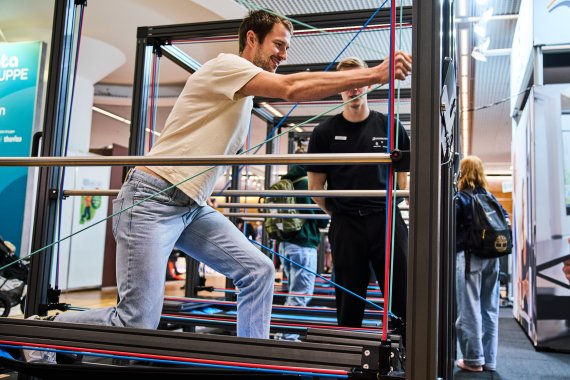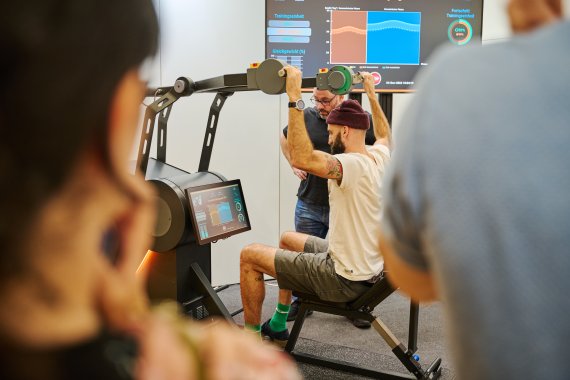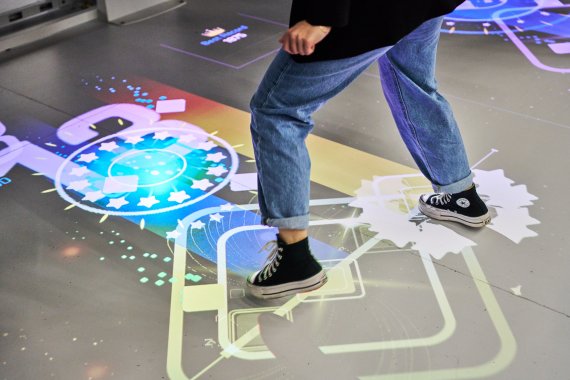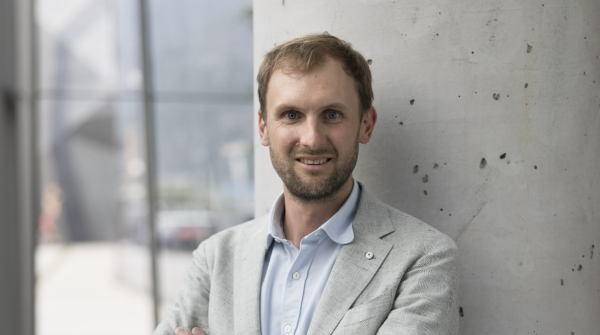When Simon Roth talks about his visions for market developments in physiotherapy, terms such as health gyms, home assessment and demographic change come up. The 42-year-old has known the market for almost two decades as a physiotherapist and since 2021 as a health tech entrepreneur: he founded Myoact with Philipp Piroth. The start-up uses electromyography (EMG) sensors to measure communication between the brain and muscles - and uses this to create individual muscle maps. The technology visualizes weak points and can check which exercises patients use to correctly target muscles. "In contrast to the blind flight of many exercise prescriptions, we offer transparency and measurability. We are the cockpit for targeted therapy," he says.
The main users of their technology currently include orthopaedic and physiotherapy practices as well as medical departments of sports clubs such as Bundesliga soccer club Eintracht Frankfurt. His vision: technologies like Myoact's will change therapy journeys ("More at home"), bring fitness, health and therapy together ("Thanks to tech, gyms will become health gyms") and help to cushion the consequences of an ageing and immobile society.
ISPO.com: What trend is currently influencing your work the most?
Simon Roth: The healthcare market has an oversupply of patients, particularly due to demographic change, but not enough practitioners. At the same time, the evidence shows that the right exercises are often more effective than passive treatments for musculoskeletal complaints. Our vision: A good physiotherapist will therefore become even more of a trainer. And a trainer, with the appropriate qualifications, will also be a therapist who works on patients - and is subsidized by health insurance companies to close this gap in care
What role does the trend towards prevention play in this?
Simon: We offer a monitoring tool, for example. It's not about immediately sounding the alarm when an injury is imminent, but about recognizing trends. If a trend develops contrary to the target state, warnings can be communicated at an early stage to prevent pain or injury. This promotes individualized medicine, has a preventive effect and relieves the system by making patients their own therapists and strengthening their self-efficacy

Your first target groups are currently orthopaedists and physiotherapists. Almost 250 of them use your technology, and what feedback have they given you?
Simon: Doctors and physiotherapists of professional athletes love it because it helps them to generate added value information that they could previously only guess at. If users express initial difficulties, it is because they are afraid of misinterpreting the app. The problem is that professionals still often make decisions based on subjective feelings and hypotheses. When we present them with the actual muscular reality, this can be perceived as overwhelming or even as questioning their previous work.
How do you address these fears?
Simon: We emphasize the concept of "clinical reasoning": you combine your previous knowledge and experience with the new information from the tool to achieve the best possible output. We initially focus on biofeedback during a single exercise. The therapist sticks the sensors on to see whether the exercise is actually working. This is a simple, self-explanatory added value that arouses curiosity. Patients can immediately see which exercises are effective in terms of neuromuscular control. Over time, the desire for standardized test protocols, our mapping, arises.
What needs to happen for practices to use standardized sensors like yours?
Simon: New technologies initially mean more work and the need to get to grips with new things, which can lead to uncertainty in front of the patient. Top elite physios are already on board, but the broader you go in the industry, the more difficult this step becomes. That's why we rely heavily on training. By instilling our mindset from the start, young physiotherapists are not yet "comfort-zone-averse".
While the majority of society is becoming increasingly overweight, others are increasingly defining health and fitness as a lifestyle.
Simon: We are also seeing this divide. Data from wearables often does not reflect the reality of the population as a whole, as these devices are primarily worn by people who are already intrinsically motivated and more active. Prevention programs often don't reach the people who need them most.
Want to know how real health solutions are created?
Then discover how ISPO brings together researchers, sports brands and manufacturers and technology providers to create a space where real solutions are developed for issues such as physical inactivity, longevity and corporate health.
From your practice: What helps inactive people to take the first steps?
Simon: We have found that data-driven feedback can change people's thinking by holding up a mirror to whether they are in an unhealthy state. Our sensors provide immediate feedback on muscle activity. This helps you get to know your own body and improves your self-efficacy. This transparency and classification motivates us to train outside our comfort zone.
Sounds like a simpler form of gamification.
Simon: It is. We also know from tests that people perform up to 10-20% better when they have a clear goal in mind, as an external focus is superior to an internal focus.
You have been collecting data on the muscular state of society for over a decade.
Simon: My co-founder and I have observed patients with EMG every day for over 15 years - and collected data from 50,000 pseudonymized measurements. Using this database, we discovered correlations between individual muscles, recognized patterns and developed algorithms. If a muscle deviates from healthy patterns during certain movements, this is often a factor in persistent pain or injury. We are now systematically validating these observations with user data and in cooperation with universities.
What do you know about the condition of Germans' back muscles, for example, thanks to the many years of data collection?
Simon: The large back extensor muscles, which are often trained, are hardly relevant and are rarely conspicuous. Instead, we see the greatest abnormalities in the pelvic muscles, especially the lateral gluteal muscles (gluteus medius). People with back problems are often unable to control these muscles sufficiently.
Your research and your product are part of the Business Incubation Center of the European Space Agency (ESA) CESAH. Why are you testing your technology in space?
Simon: As part of the joint funding project with ESA, we are currently developing an EMG suit that we will use in space to research how the body behaves during maximum inactivity - and which exercises can be used to maintain and control muscles. This will help us on Earth. Our society is becoming increasingly older and immobile. How do we move these people? There is evidence that brief bodybuilder posing of relevant muscles can result in a 20% gain in strength for senior citizens. That is enough to keep the neuromuscular system alive.

Big tech companies are also pushing into this area; Meta wants to change the way we interact with computers with its own EMG wristband. What does this commitment mean for Myoact as a start-up?
Simon: First of all, it's good because it underlines the relevance of the topic. However, we want to understand the entire body and not just develop a controller. We see a great future in the gamification of muscle functions. Imagine that in a shooter you can only shoot if you activate certain muscle groups, or in boxing you receive less damage if you tense your abdominal muscles. We believe the tech giants see this too, but we will have the largest amount of data in the background telling us what works for pain - and what doesn't.
Could Europe be missing out on a trend here?
Simon: I don't see us missing out on the trend. We are the only EMG manufacturer that collects data from patients in real practices using standardized processes. The danger is more that we could be forced to move to the USA at some point, as the investment conditions and valuations are much more attractive there. I am a European patriot and would like this to stay here, but the political framework conditions and funding in Germany/Europe are often difficult.
How are technologies like yours changing the market? Is the trend moving towards home therapy?
Simon: That is our vision. We hope to relieve the pressure on the system. It doesn't mean that physiotherapists will become redundant, but they will be able to devote more time to the manual therapy aspect. Everything that falls under self-management, self-efficacy and training is then the responsibility of the patient - supported by tools. And with the certainty that all movements and exercises are targeted and measurable.

The future of physiotherapy is being redefined by data, technology and gamification. EMG-based tools enable patients to train their muscles in a targeted manner and take preventative action. By combining home training, digital feedback and interactive exercises, fitness, health and therapy can be seamlessly brought together: a solution for an ageing and increasingly inactive society.
ISPO 2025 dedicates a separate area to the topic of health: Health & Wellbeing shares Hall B1 with Digitize & Retail, ISPO Brandnew and Sports Tech Nation. A deliberate neighborhood that creates strong synergies. Here, start-ups from the health tech sector meet retailers, platforms, wearable providers and digitalization experts. Innovative solutions are not only presented here, but also brought to life. From 30. NOV. - 02. DEZ. in Munich. Be there!
- Technology relieves the system: data-based tools reduce the workload of physiotherapists and support preventive measures.
- Physiotherapists become trainers: Professionals combine clinical knowledge with technology to improve therapy outcomes.
- Home-based assessment wins: patients increasingly perform exercises at home, supported by digital monitoring
- Gamification boosts motivation: game-like feedback increases motivation and adherence to therapy.
- Data creates transparency: EMG sensors create personalized muscle maps and help with performance monitoring and injury prevention.
- Integration of fitness & therapy: Health gyms and therapeutic services are merging and opening up new market opportunities.
- Big tech shows relevance: The entry of large technology companies underlines the importance of digital health solutions.
- Research & evidence count: Long-term data collection provides insights into the muscle health of the population and drives innovation.
- Self-management empowered: Patients take responsibility for their health, supported by measurable and targeted interventions
- Market opportunity for innovation: Start-ups and sports organizations can use technology to address the needs of an aging and less active society.

 Sports BusinessSki Mountaineering Goes Olympic: What Milano-Cortina 2026 Means
Sports BusinessSki Mountaineering Goes Olympic: What Milano-Cortina 2026 Means
- ISPO awards
- Mountain sports
- Bike
- Design
- Retail
- Fitness
- Health
- ISPO Job Market
- ISPO Munich
- ISPO Shanghai
- Running
- Brands
- Sustainability
- Olympia
- OutDoor
- Promotion
- Sports Business
- ISPO Textrends
- Triathlon
- Water sports
- Winter sports
- eSports
- SportsTech
- OutDoor by ISPO
- Heroes
- Transformation
- Sport Fashion
- Urban Culture
- Challenges of a CEO
- Trade fairs
- Sports
- Find the Balance
- Product reviews
- Newsletter Exclusive Area
- Magazine


